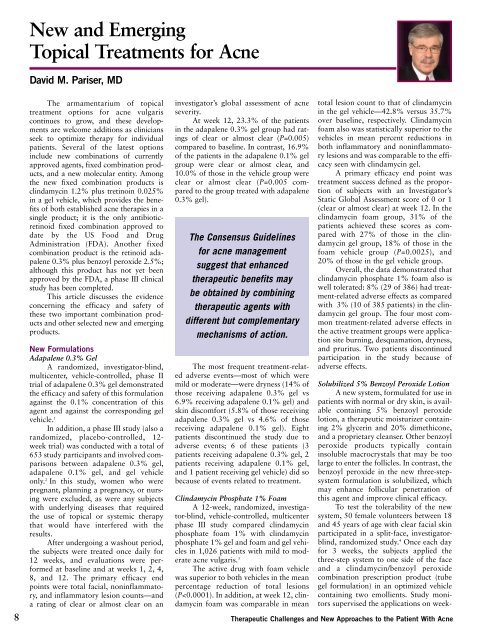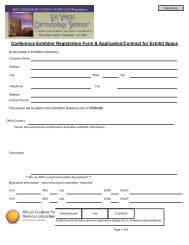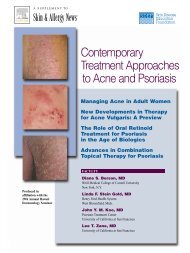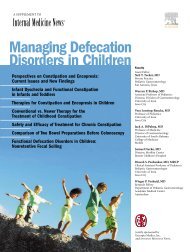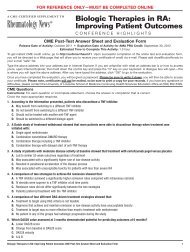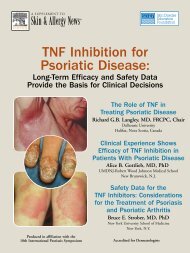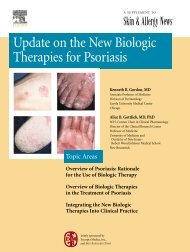Skin & Allergy News® - Global Academy for Medical Education
Skin & Allergy News® - Global Academy for Medical Education
Skin & Allergy News® - Global Academy for Medical Education
Create successful ePaper yourself
Turn your PDF publications into a flip-book with our unique Google optimized e-Paper software.
New and Emerging<br />
Topical Treatments <strong>for</strong> Acne<br />
David M. Pariser, MD<br />
The armamentarium of topical<br />
treatment options <strong>for</strong> acne vulgaris<br />
continues to grow, and these developments<br />
are welcome additions as clinicians<br />
seek to optimize therapy <strong>for</strong> individual<br />
patients. Several of the latest options<br />
include new combinations of currently<br />
approved agents, fixed combination products,<br />
and a new molecular entity. Among<br />
the new fixed combination products is<br />
clindamycin 1.2% plus tretinoin 0.025%<br />
in a gel vehicle, which provides the benefits<br />
of both established acne therapies in a<br />
single product; it is the only antibioticretinoid<br />
fixed combination approved to<br />
date by the US Food and Drug<br />
Administration (FDA). Another fixed<br />
combination product is the retinoid adapalene<br />
0.3% plus benzoyl peroxide 2.5%;<br />
although this product has not yet been<br />
approved by the FDA, a phase III clinical<br />
study has been completed.<br />
This article discusses the evidence<br />
concerning the efficacy and safety of<br />
these two important combination products<br />
and other selected new and emerging<br />
products.<br />
New Formulations<br />
Adapalene 0.3% Gel<br />
A randomized, investigator-blind,<br />
multicenter, vehicle-controlled, phase II<br />
trial of adapalene 0.3% gel demonstrated<br />
the efficacy and safety of this <strong>for</strong>mulation<br />
against the 0.1% concentration of this<br />
agent and against the corresponding gel<br />
vehicle. 1<br />
In addition, a phase III study (also a<br />
randomized, placebo-controlled, 12-<br />
week trial) was conducted with a total of<br />
653 study participants and involved comparisons<br />
between adapalene 0.3% gel,<br />
adapalene 0.1% gel, and gel vehicle<br />
only. 2 In this study, women who were<br />
pregnant, planning a pregnancy, or nursing<br />
were excluded, as were any subjects<br />
with underlying diseases that required<br />
the use of topical or systemic therapy<br />
that would have interfered with the<br />
results.<br />
After undergoing a washout period,<br />
the subjects were treated once daily <strong>for</strong><br />
12 weeks, and evaluations were per<strong>for</strong>med<br />
at baseline and at weeks 1, 2, 4,<br />
8, and 12. The primary efficacy end<br />
points were total facial, noninflammatory,<br />
and inflammatory lesion counts—and<br />
a rating of clear or almost clear on an<br />
investigator’s global assessment of acne<br />
severity.<br />
At week 12, 23.3% of the patients<br />
in the adapalene 0.3% gel group had ratings<br />
of clear or almost clear (P=0.005)<br />
compared to baseline. In contrast, 16.9%<br />
of the patients in the adapalene 0.1% gel<br />
group were clear or almost clear, and<br />
10.0% of those in the vehicle group were<br />
clear or almost clear (P=0.005 compared<br />
to the group treated with adapalene<br />
0.3% gel).<br />
The Consensus Guidelines<br />
<strong>for</strong> acne management<br />
suggest that enhanced<br />
therapeutic benefits may<br />
be obtained by combining<br />
therapeutic agents with<br />
different but complementary<br />
mechanisms of action.<br />
The most frequent treatment-related<br />
adverse events—most of which were<br />
mild or moderate—were dryness (14% of<br />
those receiving adapalene 0.3% gel vs<br />
6.9% receiving adapalene 0.1% gel) and<br />
skin discom<strong>for</strong>t (5.8% of those receiving<br />
adapalene 0.3% gel vs 4.6% of those<br />
receiving adapalene 0.1% gel). Eight<br />
patients discontinued the study due to<br />
adverse events; 6 of these patients (3<br />
patients receiving adapalene 0.3% gel, 2<br />
patients receiving adapalene 0.1% gel,<br />
and 1 patient receiving gel vehicle) did so<br />
because of events related to treatment.<br />
Clindamycin Phosphate 1% Foam<br />
A 12-week, randomized, investigator-blind,<br />
vehicle-controlled, multicenter<br />
phase III study compared clindamycin<br />
phosphate foam 1% with clindamycin<br />
phosphate 1% gel and foam and gel vehicles<br />
in 1,026 patients with mild to moderate<br />
acne vulgaris. 3<br />
The active drug with foam vehicle<br />
was superior to both vehicles in the mean<br />
percentage reduction of total lesions<br />
(P


